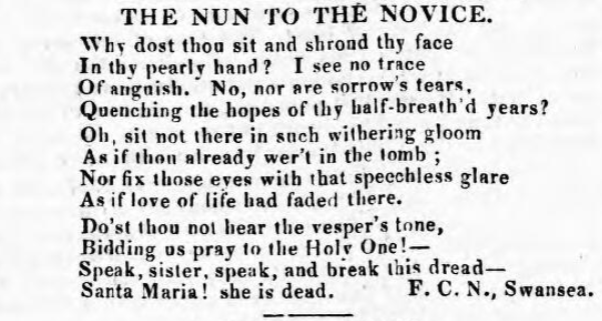Proud to have a post on the excellent Legal History Miscellany blog this week: https://legalhistorymiscellany.com/2021/02/17/allure-of-the-runaway-nun/ about medieval nuns.
To be honest, I have not spent that much of my life thinking about nuns – academically speaking, they have always seemed to be pretty much covered by ‘proper’ historians, church historians, and scholars of literature, art and music (Hildegard …), and a Presbyterian upbringing meant I didn’t come into contact with nuns very much at all in real life (still not sure I have ever spoken to one). But they are interesting from a common law legal history point of view. There is the stuff I touched on in the LHM post, but also a lot more in terms of working out how to enable them to act at common law, if they were enclosed and unable to come to court, and issues around women being forced into convents to allow other family members to snaffle up their property rights. And then there is the fact that all of the common law learning must, presumably, have become more or less redundant after the dissolution of religious houses in the 16th C. It would be quite a fascinating project to trace what happened to it – were nuns still referred to, or used as examples, in common law treatises after that? How did it compare, e.g., to the ways in which law about Jews was referred to, after the 1290 Expulsion? Another one for the queue for the back-burner …
In the meantime – and it’s a bit of a nun sequitur (I’m trying to make that one happen ..) – in a trawl of the Welsh Newspapers Online archive, I found a ‘so-terrible-it’s-great’ poem about nuns in an issue of The Cambrian from 1839 which deserves much wider publicity: the gem at the head of the post.(1) Even by the standards of the day, it is mawkish in the extreme, and the last line is an absolute corker. Ka-blam – she wasn’t sad, she was dead! I love the idea of some hard nosed Swansea businessman sitting and reading his paper, moving between the price of copper (which is just above it) and this fabulous work. Surely ‘F.C.N.’ deserves to be better known.
GS
19/2/2021
(And PS – look up any word in this database, and there will be a racehorse with that name. There was one called Defamation, in my last search, relating to that subject. This time, we have the late 19th C horse ‘Nun Nicer’ – good to see a bit of nun-punning going on there … And there’s even a ‘Seabourne’ in the early 1900s – oh come on, as if we don’t all look our names up in these things – though in my case it is to find some of the ne’er do wells of my family in court records – nothing serious, other than being thrown out of a workhouse, and being caught for chicken stealing because of suspicious feathery debris on his clothes – Ymlaen Wncl Joseph!)
